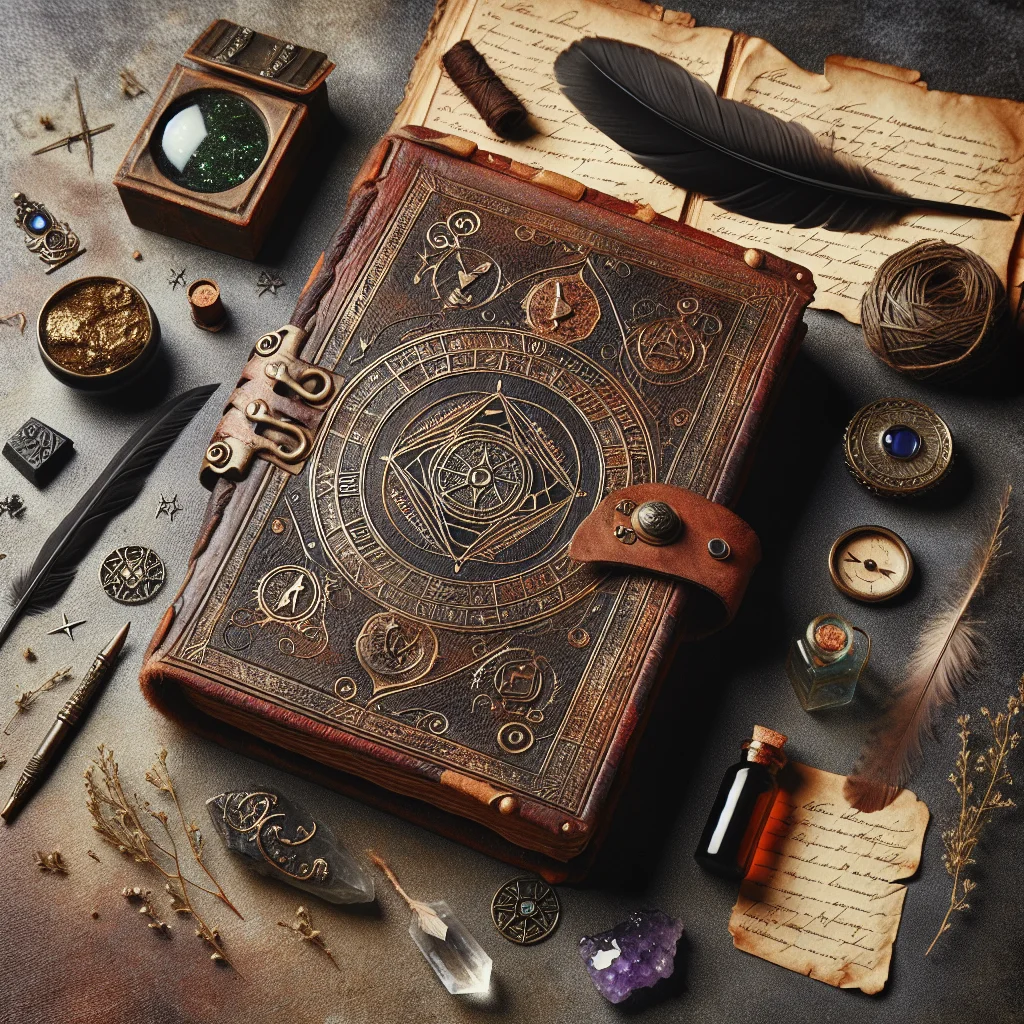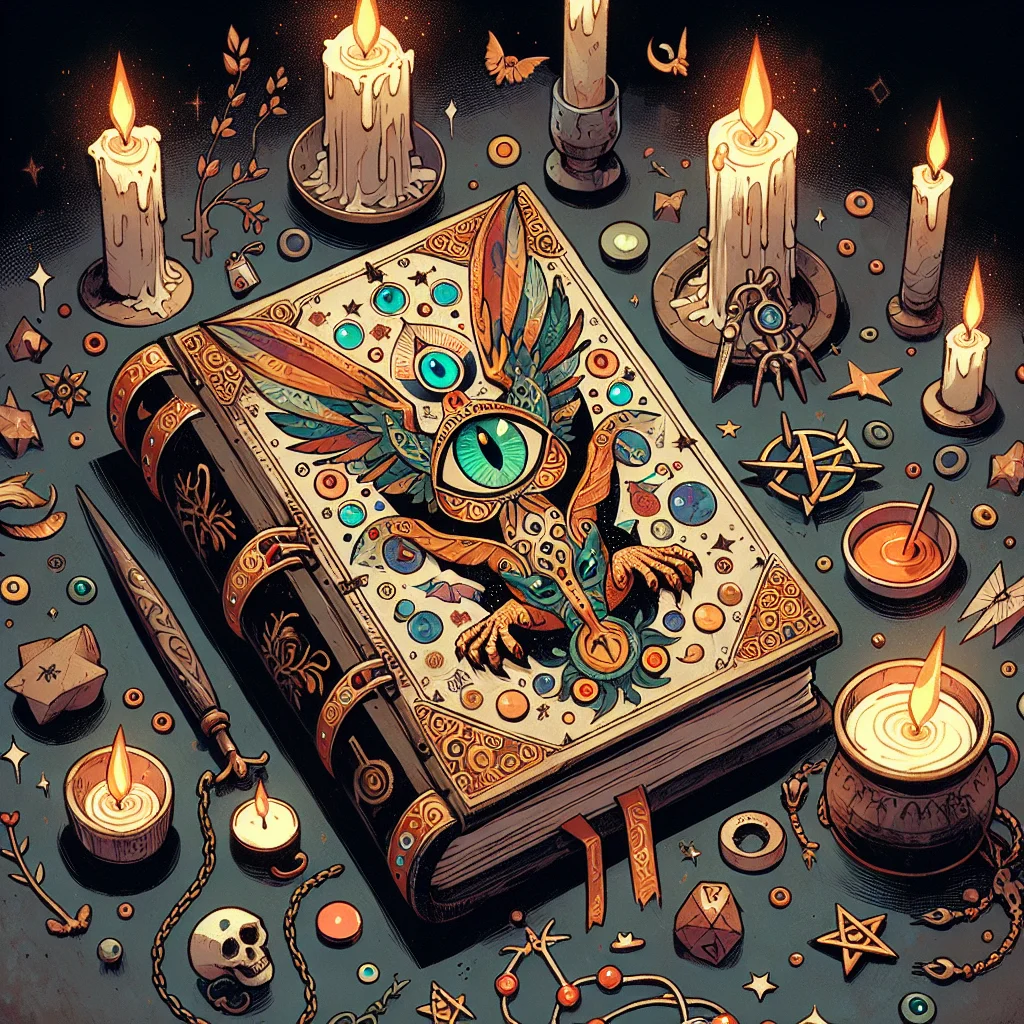As an Amazon Associate I earn from qualifying purchases.

Since ancient times, magic practitioners have compiled their knowledge into grimoires or spell books – collections of spells, rituals, magical correspondences, and guidelines for magical work. These storied volumes serve as vital references for initiating into the mysteries of magic and weave relatable stories acknowledged by many folklore traditions across the world. They chart the trajectory of magical practices through centuries, chronicling not just spells but the evolution of witchcraft and the occult itself.
The personalisation of a spell book gives it a unique character – it reflects the individual nature of the practitioner’s journey through the realm of magic. In crafting your own spell book, you’re participating in a tradition that spans countless generations and cultures, each volume a sacred reflection of the sorcerer who created it. This custom helps modern practitioners connect with their mystical heritage, turning every blank page into a testament of their magical exploration and growth.
A spell book serves not only as a repository of knowledge but as an intimate space for creative expression. Within its pages, one may carve runes, inscribe incantations, or press sacred plants, transforming the book into a talisman itself. Surveys suggest that many modern practitioners find the act of writing by hand enhances their memory and connection to their craft. Furthermore, the tactile experience of engaging with a physical text can deepen the sentiment of a spell, imbuing it with emotional power and personal significance.
One engaging component of creating a spell book is deciding on its materials. Whether it is bound in leather or cloth, fashioned with recycled paper or parchment, each choice imparts a subtle influence on the book’s magical properties. Some may even incorporate papers imbursed with herbs corresponding to their intentions, weaving additional layers of enchantment into their spellwork.
Integration of symbols and imagery into one’s spell book is both practical and profound. Through the use of sigils, illustrations, and color symbolism, practitioners can quickly reference their desired spells. The artistic process of creating these elements is a ritual in itself, charging the book with one’s focused intentions and energies. Moreover, such illustrations serve as visual triggers, potentially enhancing the efficacy of the spells cast from its pages.
An often overlooked but critical aspect is the organization of the spell book. Deciding the order in which spells are listed – whether by purpose, seasonal association, or phase of the moon – can shape the practitioner’s magical workflow. By structuring their spell book thoughtfully, one might find clarity and efficiency in their practice, allowing for smoother transitions between magical workings.
In addition to spells, recording observations, results, and reflections on spellwork is of utmost importance for a growing practitioner. A spell book can also function as a magical diary, noting lunar phases, astrological conditions, or even personal feelings at the time of a ritual. This comprehensive approach not only provides historical data for future reference but also encourages introspection and continuous learning.
Remember that the process of crafting a spell book can evolve over time. As practitioners develop their craft, they may choose to revise or expand their content, reflecting their journey’s progression. Thus, a spell book is not only a creation but a chronicle of one’s evolving relationship with magic.
Creating a spell book is a deeply personal and magical endeavor. Here are 22 tips to guide you as you craft your own:
1. Set Your Intentions: Before beginning, decide on the purpose of your spell book. Will it be for rituals, daily guidance, or a record of your magical journey?
2. Choose Quality Materials: Select a notebook or journal that feels special to you. Consider the durability of the binding and the type of paper that will hold your ink without bleeding.
3. Personalize the Cover: Decorate the cover of your spell book in a way that resonates with your magical identity. This can involve painting, collaging, or embossing symbols that are meaningful to you.
4. Dedicate Your Book: Write a dedication or blessing at the beginning of your spell book to consecrate it for magical work and to set the tone for its contents.
5. Create a Table of Contents: Keep your spells organized by including a table of contents that you can update as your spell book evolves.
6. Leave Blank Spaces: Give yourself room to add notes, additional insights, or variations to your spells over time.
7. Include Dates: Record the date when you write or perform a spell. This helps in tracking astrological influences and the development of your practice.
8. Document the Moon Phases: Integrate the lunar cycle into your spell work by noting the moon phase associated with each spell and observing its effects.
9. Record the Ingredients: Clearly list all the materials and ingredients needed for each spell, noting any substitutions you make.
10. Detail the Steps: Write clear, step-by-step instructions for your spells to ensure they can be easily repeated or adapted.
11. Note the Outcomes: After performing a spell, jot down the results and any feelings or signs associated with the work.
12. Sketch and Color: Include drawings, diagrams, and color in your spell book to illustrate concepts or add energetic vibrations to your spells.
13. Add Quotations and Poems: Integrate inspiring quotes or personal poetry that capture the spirit of your magical work.
14. Embrace the Seasons: Align your spell book with the Wheel of the Year by marking seasonal festivals and crafting spells that honor these times.
15. Use Protective Symbols: Incorporate protective sigils or symbols throughout your spell book to shield it from unwanted influences.
16. Keep Secrets Safe: Develop a cipher or code to keep particularly sensitive spells secure from prying eyes.
17. Store Correspondences: Include a section for correspondences, like colors, herbs, and crystals, to enhance your spell crafting.
18. Reflect and Revise: Regularly reflect on your spells and practices, revising them as you grow in knowledge and experience.
19. Invite Collaboration: If you’re part of a coven or magical community, consider including collaborative spells or shared wisdom.
20. Respect Traditions: If you’re drawing on established traditions, ensure you accurately record their spells and credit sources appropriately.
21. Craft Regularly: Treat your spell book as a living document, adding to it consistently as part of your magical practice.
22. Prioritize Privacy: Keep your spell book in a safe, private space to protect the energy and integrity of your work.
Crafting a spell book is not just about recording spells—it’s a creative act that weaves together personal power, intention, and the fabric of the magical world. According to a survey by the Pagan Federation International, approximately 90% of modern practitioners consider their personal spell book or Book of Shadows as an essential tool in their spiritual practice, underscoring the profound importance such tomes hold within magical communities.
1. What is a spell book, and why would I want to create my own?
A spell book is a collection of spells, rituals, and magical information that is used by practitioners of witchcraft, wizardry, or other magical traditions. Crafting your own spell book allows you to personalize and compile spells and rituals that resonate with your individual practice, beliefs, and intentions, making your magical workings more potent and significant to you.
2. Do I need to be a certain level of experience to create a spell book?
No, you do not need to have a certain level of experience to create your own spell book. Beginners and seasoned practitioners alike can benefit from assembling a book of spells and magical knowledge. It will reflect your journey and grow with you as you gain more experience and insights.
3. What materials do I need to start crafting my spell book?
To start crafting your spell book, you’ll need a notebook, journal, or binder that resonates with you, writing tools, and any decorative items you might want to include, such as stickers, drawings, or pressed flowers. You may also want to gather reference materials for your spells and rituals.
4. Can I use digital tools to create my spell book, or does it have to be handwritten?
You can definitely use digital tools to create your spell book. Many people find that a digital format is more convenient for editing and organizing their work. However, some practitioners prefer the personal touch and energy of a handwritten book. The choice is entirely up to your preference and practice.
5. How do I organize the contents of my spell book?
You can organize your spell book in a way that makes sense to you. Common methods include categorizing by the type of spell (love, prosperity, protection, etc.), by the phase of the moon, by season, or in the order you learn them. Include a table of contents for easy reference.
6. What should I do if I make a mistake in my spell book?
Don’t worry if you make a mistake in your spell book. Some people believe that mistakes are part of the process and can choose to leave them as is. Alternatively, you can use correction fluid or tape, paste over the page, or rewrite the section on a new page. Remember, it’s your book and it doesn’t need to be perfect.
7. Can I include spells from other sources in my spell book, or do they have to be original?
It’s completely acceptable to include spells from other sources in your spell book. Many practitioners start with spells they’ve learned from others and modify them over time. However, always give credit where it’s due and don’t reproduce content for commercial use without permission.
</ UserControl can include details like the timing of the spell (such as the phase of the moon or day of the week), ingredients needed, the steps to follow, and any notes on the outcomes or adjustments made for future reference. You can also write down the purpose of the spell and why it's important to you.
9. Is it necessary to consecrate my spell book, and if so, how do I do it?
Many practitioners choose to consecrate their spell book to cleanse and bless it for magical work. To consecrate your book, you could perform a simple ritual that might involve elements like sage smudging, anointing with oils, setting intentions, or calling on deities or the elements for protection and guidance. However, this step is personal and not strictly necessary.
10. How do I ensure my spell book’s energy stays positive and potent?
To ensure your spell book’s energy stays positive and potent, regularly cleanse it energetically using methods such as smudging with sage or incense, placing it in moonlight, or using crystals. It’s also important to handle your book with respect, store it in a safe place, and possibly establish a protective charm or barrier around it.

Conclusion
In essence, creating your own spell book is a deeply personal journey that intertwines your magical practice with your unique creative expression. Throughout the article, we emphasized the importance of selecting the right materials that resonate with you, like the paper and binding, to help set the tone for your spell work. We also discussed the significance of organizing your content in a way that reflects your approach to magic, whether it’s through meticulous categorization or a free-flowing, intuitive arrangement.
Moreover, the article highlighted the value of imbuing your spell book with intentionality at every step, from hand-writing spells to enhance their potency to charging individual pages with specific energies. Personalizing your spell book with your own artwork, photographs, or meaningful symbols not only enriches its aesthetic but also reinforces the power of the spells within. Above all, your spell book should be a living document that evolves alongside your practice, giving you the space to record new insights, experiences, and spells that reflect your growth as a practitioner of the craft. Remember, crafting your spell book is not a one-time task but an ongoing process of reflection, experimentation, and magical discovery.
Amazon and the Amazon logo are trademarks of Amazon.com, Inc, or its affiliates.


